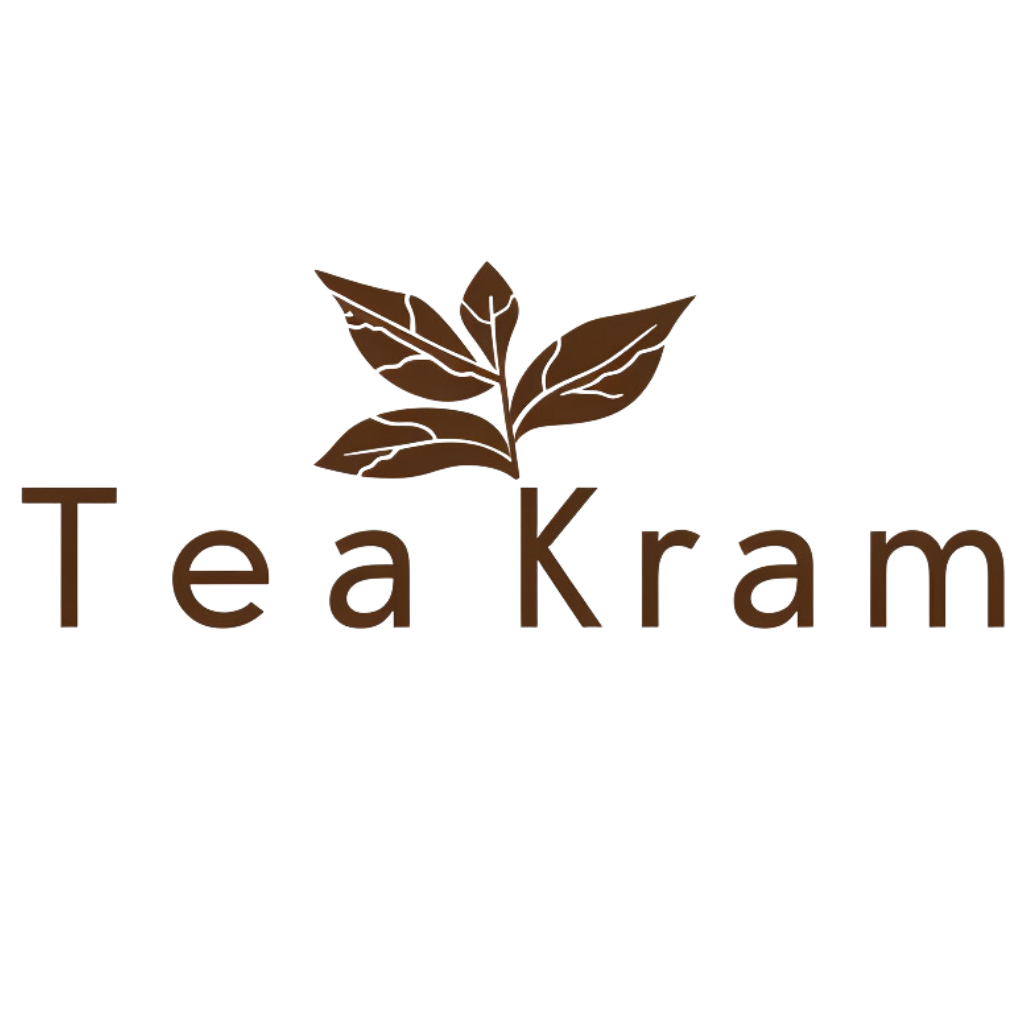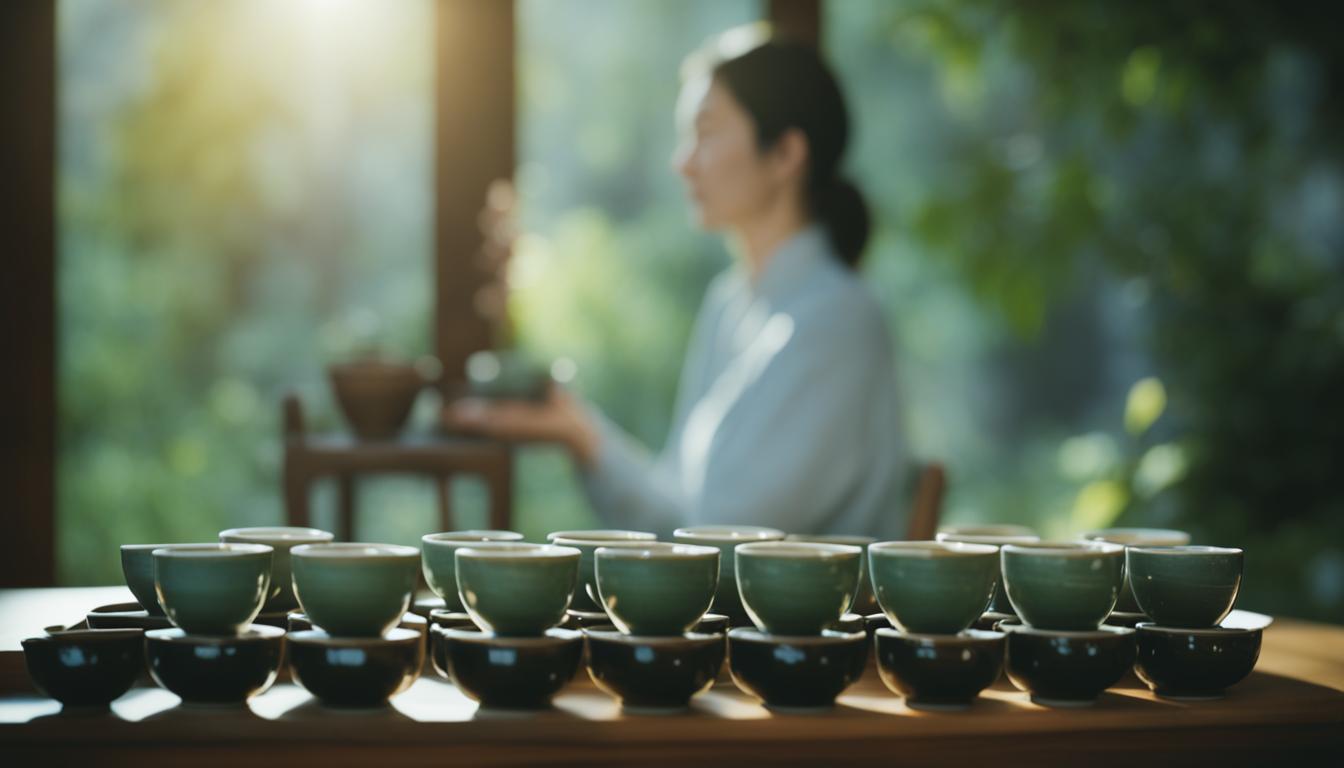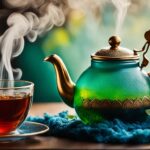Embarking on the path to becoming a tea connoisseur begins with the first sip and an open heart to the myriad of aromas and flavors that tea has to offer. Tea tasting for beginners is not just about learning how to taste tea; it’s about cultivating a moment of introspection, a ritual that connects you to the ancient traditions and the subtle notes present in your cup. This vast and aromatic world is waiting for you to explore its depths, inviting a sense of wonder with each taste.
Brewing that first kettle, inhaling the warm, comforting aromas, and taking the mindful sip is more than a mechanical process—it’s the beginning of a sensory journey. Each infusion has a story, a legacy of soil and seasons—the joy of tea tasting comes from unraveling these layers. Welcome to a transformative process that not only enriches your taste buds but also nourishes your soul, as you start to find your individual palate within this global tapestry.
Key Takeaways
- Discovering the art of tea tasting can be a rewarding journey of sensory expansion.
- Tea tasting begins with appreciating the diverse flavors and aromas across different tea varieties.
- Understanding the flavor profile of a tea requires patience and a keen sense of taste and smell.
- Developing a palate for tea tasting is an enriching experience that grows with practice and curiosity.
- The transformation from a beginner to a tea connoisseur is marked by a deeper connection to the cultural history and craftsmanship behind each tea.
- Every cup of tea offers a narrative that extends beyond taste, encompassing the terroir and tradition it stems from.
Discovering the World of Tea Types and Flavors
Embarking on a journey through the world of tea reveals a vast panorama of sensory experiences. For enthusiasts, understanding the distinct categories of tea types and the exceptional flavors they offer is akin to exploring a new cultural landscape. With each variety comes a unique profile, shaped by tradition, cultivation, and processing techniques.
Exploring Varieties: Green, Black, White, and Oolong
The four primary tea types – green, black, white, and oolong – are distinguished not just by color but by the intricacies of their flavor, body, and aroma. Green tea is celebrated for its grassy notes and vibrant freshness, while black tea is known for its robustness and depth. White tea delicately whispers of purity and subtlety, and oolong tea offers a complex symphony of taste, ranging from floral to smoky nuances.
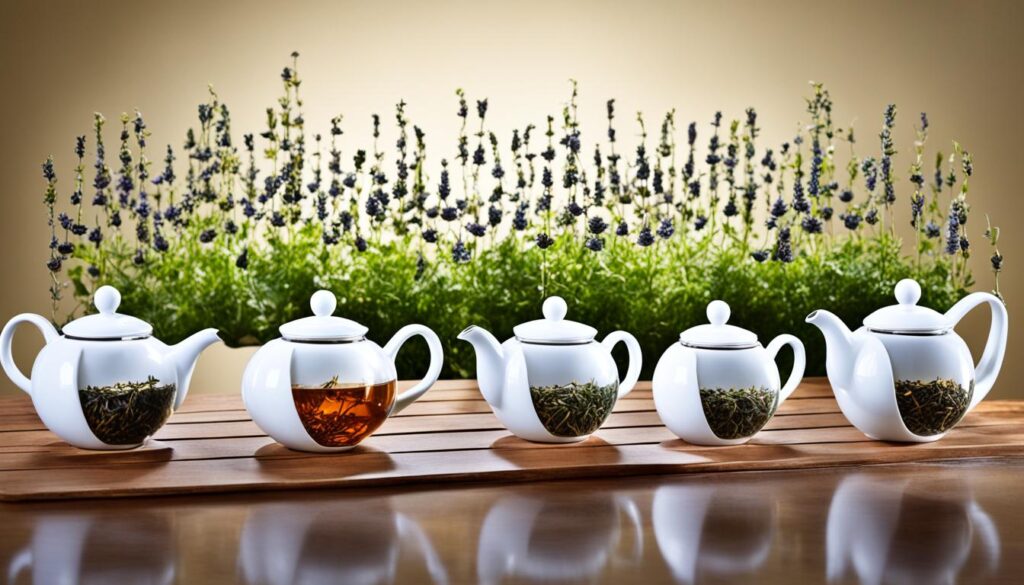
Understanding Flavor Profiles: Bitterness, Sweetness, and Aroma
The enjoyment of tea extends well beyond its basic taste to include an elaborate interplay of bitterness, sweetness, and an aromatic bouquet that can transport the mind to distant places. A well-crafted tea balances these elements harmoniously, providing an experience that is both invigorating and soothing. The aroma, especially, is a powerful vehicle, carrying whispers of the tea’s origin—be it a misty mountain or a sun-drenched plain.
| Tea Type | Bitterness | Sweetness | Aroma |
|---|---|---|---|
| Green Tea | Low – Medium | Delicate | Fresh, Grassy |
| Black Tea | Medium – High | Subtle | Rich, Malty |
| White Tea | Low | Light | Floral, Sweet |
| Oolong Tea | Varies | Varied | Diverse, Often Floral |
The Impact of Origin and Terroir on Tea Characteristics
As with fine wine, the concept of terroir holds a special significance in the world of tea. The geography, climate, and soil where tea plants grow profoundly shape their resultant flavors and aromas. For instance, Darjeeling teas are treasured for their muscatel highlights, a unique trait bestowed by the region’s altitude and weather patterns. The physical world leaves an indelible imprint on every leaf, contributing to the expansive variety that exists within each tea family.
- Darjeeling – Muscatel grace, gentle bite
- Assam – Full-bodied richness, malty notes
- Fujian – Orchid-like fragrance, mellow smoothness
- Yunnan – Peppery zest, earthy undertones
As one continues to navigate this flavorful terrain, every steeped cup becomes a testament to nature’s diversity—a tangible intersection of culture, environment, and artistry. This is the appeal and the delight of tea, encouraging aficionados to uncover and savor its many treasures.
The Art of Tea Brewing Methods for Optimal Flavor
The process of brewing tea is both an ancient cultural art and a modern culinary science. Understanding the details of tea brewing methods, including the selection of tea leaves and the mastery of technique, is essential to achieving optimal flavor in every cup. Let’s explore the practices that can transform your tea experience from ordinary to extraordinary.
Choosing the Right Water Temperature and Quality
Water, the essence of all life, is also the foundation of perfect tea brewing. The temperature of the water can significantly alter the taste and aroma of the brewed tea. Notably, green tea requires cooler water around 150-180 degrees Fahrenheit to avoid burning sensitive leaves, whereas black tea thrives in hotter water, typically between 200-212 degrees Fahrenheit. Similarly, white and oolong teas fall between these ranges, each unlocking its unique flavor at a specific temperature.
The quality of water is as crucial as the temperature. Tap water often contains minerals or contaminants that can interfere with the taste of your tea. For an unadulterated flavor, use filtered or spring water, free from chemicals and heavy metals.
The Importance of Steeping Time for Different Tea Leaves
Steeping time, the interval during which tea leaves are submerged in water, is pivotal in crafting the perfect brew. Each type of tea demands a distinct steeping duration to fully release its nuanced flavors without succumbing to bitterness. A brief steep of 1-2 minutes might suffice for some delicate green teas, while robust black teas could need up to 5 minutes.
It’s essential to mention that over-steeping can lead to an overwhelmingly bitter or astringent taste, while under-steeping may result in a lackluster infusion. Discovering the sweet spot for steeping each variety of tea leaves ensures a cup that is balanced and satisfying.
Equipment Essentials for Tea Brewing
The tools used in brewing tea play an instrumental role in influencing its quality. A kettle with precise temperature control can be invaluable for heating water to the exact degree necessary for different tea types. Similarly, a teapot that allows tea leaves to expand and a fine mesh strainer or infuser are key for a clean and clear brew.
Consider materials as well: glass and ceramic preserve the tea’s flavor without adding any foreign taste, as compared to metal or plastic which could potentially alter the flavor profile.
Keep in mind that mastering tea brewing is a journey of continuous learning. Enjoy the ritual, savor the process, and celebrate the many cups of tea that await on the path to becoming a true connoisseur of this time-honored beverage.
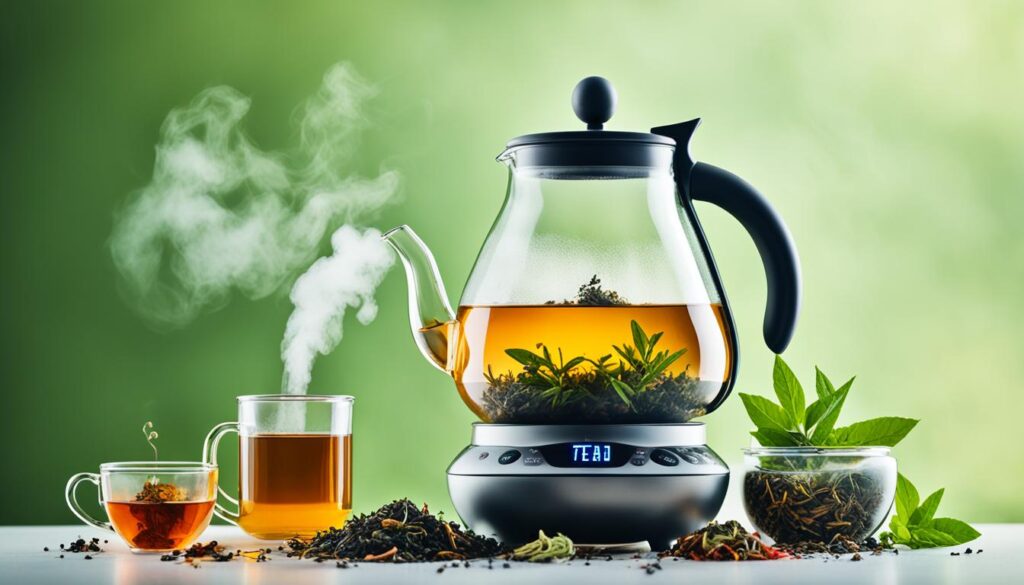
Tea Tasting for Beginners: Enhancing Your Palate
Embarking on a journey of tea tasting for beginners is akin to entering a new world rich with flavors, aromas, and traditions. The key to fully enjoying this experience lies in enhancing your palate, which allows you to discern and appreciate the subtle complexities inherent in each brew. This section lends insightful strategies to refine your taste buds and guide you towards becoming a more perceptive and knowledgeable tea enthusiast.
The road to developing an acute sense of taste is one of patience, mindfulness, and constant exploration. A beginner’s palate is like a canvas, ready to be painted with a myriad of taste experiences, each sip adding depth and color to the overall picture.
- Start with classic teas and gradually incorporate more exotic blends to challenge and expand your palate.
- Engage in regular tasting sessions, focusing on a single variety to identify unique notes and characteristics.
- Pair teas with a variety of foods to understand how flavors interact with one another.
- Document your tasting adventures to track your development and recognize patterns.
It is during these tasting experiences that a simple cup of tea becomes a symphony of sensations, where every note matters and contributes to the drinker’s pleasure.
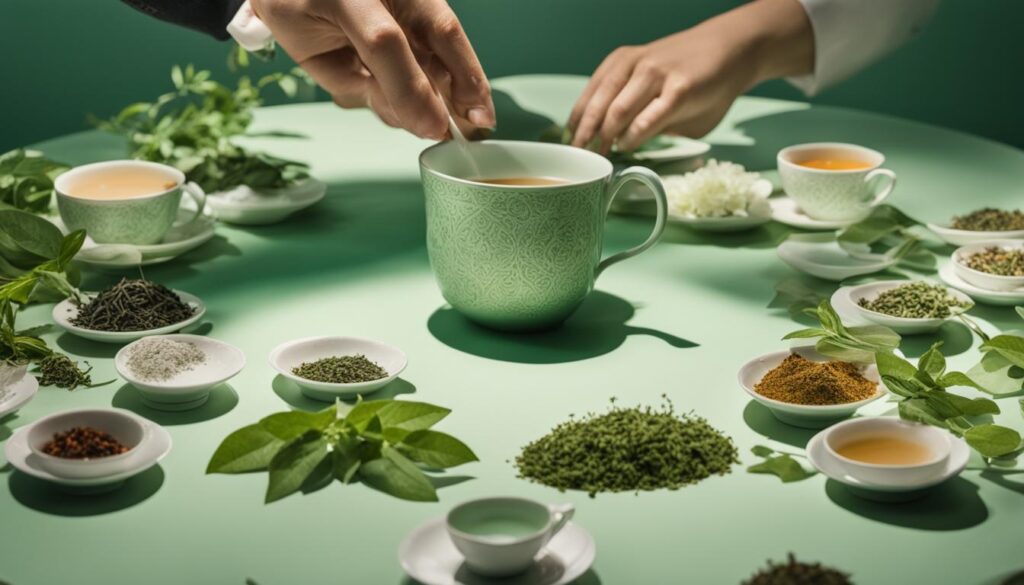
| Tea Type | Characteristic Flavors | Suggested Tasting Tips |
|---|---|---|
| Green Tea | Grassy, vegetal, fresh | Pay attention to any sweetness or astringency balancing the fresh flavors. |
| Oolong Tea | Floral, fruity, creamy | Focus on the smooth transition between floral notes and a creamy finish. |
| Black Tea | Malty, robust, astringent | Notice the boldness of the malt against the backdrop of astringency. |
| White Tea | Delicate, sweet, honey-like | Observe the subtlety of flavors as white teas often have nuanced profiles. |
A beginner must approach tea tasting with an open mind and a willingness to experience the unknown. As you> indulge in the nuanced dance of flavors, you not only enhance your palate, but you also cultivate a sense of presence and appreciation for the present moment, letting it infuse the very essence of your tea tasting journey.
“Tea is the elixir of life.” – Eisai
Whether you are sipping on a delicate white tea or a full-bodied black tea, every experience is a step towards embracing the full spectrum of exquisite tastes that the world of tea has to offer. Savor each sip and allow the knowledge of tea tasting for beginners to unfold as you refine your palate and discover the joy in every cup.
Mastering Tea Tasting Techniques and Notes
Embarking on the path of a tea connoisseur involves more than just sipping on your favorite brew; it requires honing specific skills unique to the craft. In this vital section, we unwrap the intricacies of tea tasting techniques that will not only enhance your experience but also refine your capacity to appreciate the myriad flavors that tea has to offer.
How to Taste Tea: Engaging Your Senses
Tea tasting is an art that calls for the full engagement of your senses. Begin by observing the appearance and color of the tea—this visual pleasure sets the stage for what’s to come. Then, take in the aromas; let the fragrance notes of the tea leaves tantalize your olfactory senses, offering hints of their origin and processing. By embracing a deliberate and mindful approach to each sip, allowing the liquid to wash over your palate, you detect delicate flavors and textures—an essential part of tea tasting techniques. Finally, listen to the sound of the tea being poured; it adds a sensory layer to the rich tapestry of the tea tasting experience.
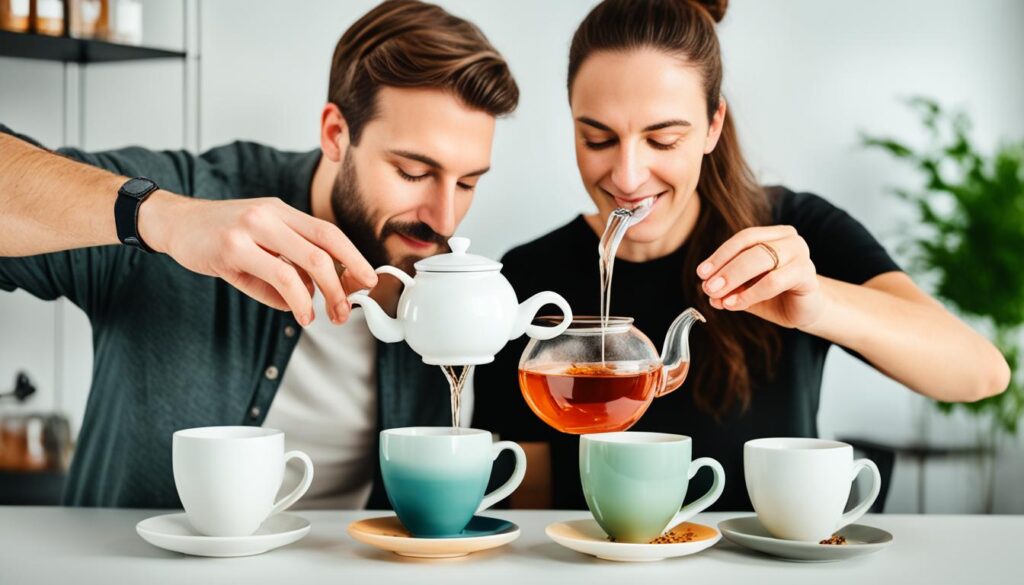
Recording Your Impressions: The Tea Tasting Notes
Developing a record of tea tasting notes is pivotal for any budding tea connoisseur. It’s more than a diary; it’s a tool of introspection and learning. Note the name, origin, and type of the tea, including the date of your tasting session. Jot down your impressions—the body, astringency, sweetness, and any associative memories. Equipping yourself with a systematic way to document these details enriches your understanding and appreciation of the nuances, thereby marking your progress in the tea tasting journey.
Developing a Tea Connoisseur’s Vocabulary
Amplitude in expression comes from a rich vocabulary, and this is no different for those steeped in the tea culture. As you delve into tea tasting notes, challenge yourself to articulate the experience with precision and flair. Phrases like ‘velvety texture’, ‘notes of citrus’, or ‘peppery finish’ can vividly portray the character of the tea to others. By expanding your descriptive language, you transform from a passive enthusiast into an active participant in the world of tea, engaging in meaningful conversations with fellow connoisseurs.
Conclusion
As we reach the end of this guide, your journey into tea tasting is just beginning. This expedition into the aromatic and flavorful world of teas is one of continuous discovery and delight. It’s a path that not only deepens your knowledge and sharpens your senses but also enriches your daily life with every cup you savor. Embrace this journey as an opportunity to explore cultures, traditions, and the immense diversity that tea has to offer. Let your curiosity and newfound skills lead you towards personal growth and an enhanced appreciation for this ancient beverage.
Starting Your Journey into Tea Tasting
Embarking on this journey into tea tasting, remember that each sip is a step towards becoming a tea expert. Take pleasure in the nuances of different brews, the serene moments of steeping, and the vibrant communities of fellow enthusiasts. Every tasting is a chance to refine your palate, learn from the complex characters of each tea, and build a reservoir of sensory experiences.
Next Steps to Becoming a Tea Expert
As you progress on your path, continual learning is key. Delve into books about tea history, production techniques, and cultural practices. Experiment with different brewing methods, attend tastings whenever possible, and engage with other tea lovers to exchange knowledge and insights. By immersing yourself in the learning process and practicing your tasting techniques, you’ll find that the route to becoming a tea expert is not only educational but also incredibly gratifying and enjoyable.
FAQ
What are the first steps to take when getting into tea tasting as a beginner?
The journey into tea tasting for beginners starts with exploring different tea types and flavors. Begin by sampling a variety of basic categories such as green, black, white, and oolong teas. Learn to observe the aroma, color, and taste, and take simple notes on your experiences to enhance your awareness of your preferences and palate.
How do different tea types vary in flavor and aroma?
Each tea type—green, black, white, and oolong—has a unique flavor profile due to its specific processing methods. Green teas tend to have a grassy, fresh taste, black teas are more robust and malty, white teas offer a delicate and sweet nuance, while oolong teas can range from fruity to woody, depending on the oxidation level. Aroma also varies significantly; some teas may have a floral, earthy, or even smoky scent.
Why is the temperature and quality of water important in tea brewing?
The right water temperature is crucial for optimal flavor extraction without burning the tea leaves. For instance, green teas are best brewed with water well below boiling, while black teas can tolerate higher temperatures. Similarly, water quality affects taste; filtered or spring water is recommended to ensure that no impurities alter the tea’s natural flavors.
What are the appropriate steeping times for different tea leaves?
Steeping time varies by tea type. Green and white teas may require 1-3 minutes, oolong teas 3-5 minutes, and black teas 4-6 minutes. The right steeping time helps to extract the full breadth of flavors without causing bitterness from over-extraction. Observing the color and taste during the steeping process can help you decide the perfect moment to end the infusion.
How can I enhance my palate for a better tea tasting experience?
Enhancing your palate involves exposing yourself to a broad range of teas and consciously tasting them. Pay close attention to the flavors and sensations in each sip, and try to identify the individual notes. Comparing teas and keeping a tasting journal can also help. Over time, your ability to discern subtle differences and appreciate complex profiles will grow, enriching your tea tasting experience.
What are important tea tasting techniques?
Important tea tasting techniques include engaging all your senses. Look at the color and clarity of the tea, inhale its aroma deeply, take sips to savour the taste and mouthfeel, and even listen to the sound of the water pouring and the leaves unfurling. Pay attention to your initial impression, the body or fullness, and the aftertaste that lingers. Mastering these techniques is a key step toward becoming a tea connoisseur.
Why should I keep tea tasting notes?
Keeping tea tasting notes helps you to track and remember your experiences with different teas. It’s an invaluable tool for recognizing patterns in flavors and aromas you enjoy, documenting your journey in developing your palate, and reminding yourself of the specific conditions, like brewing time and temperature, that produced your preferred cup.
What should be included in a tea connoisseur’s vocabulary?
A tea connoisseur’s vocabulary encompasses terms for aroma (e.g., floral, earthy, smoky), flavor (e.g., sweet, bitter, umami), and mouthfeel (e.g., astringent, creamy, silky). Knowing these terms not only helps in articulating your tasting experiences accurately but also enhances your ability to appreciate and describe the complexities of tea to others.
